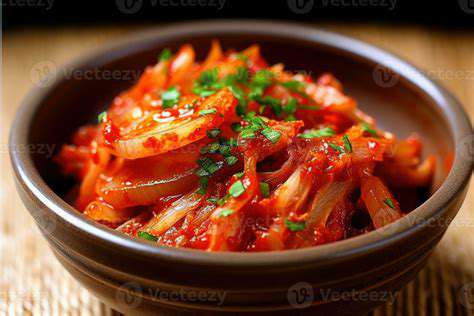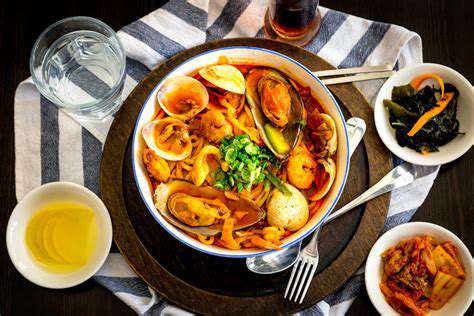Eating Habits in Korea: Kimchi and Banchan

Kimchi's Complex Flavor Profile
Kimchi, the iconic fermented Korean dish, offers a flavor journey unlike any other. Its taste evolves from the careful marriage of ingredients, time-honored preparation methods, and the alchemy of fermentation. What truly sets kimchi apart is how the fermentation process unlocks deeper flavors over weeks or months, creating something greater than the sum of its parts. The initial crispness of napa cabbage gives way to complex layers where sweet, spicy, and sour notes dance together.
Beyond the obvious garlic and chili, subtle undertones emerge - the earthy depth of fermented seafood, the bright acidity of lactic acid, and sometimes even fruity esters. This complexity explains why kimchi works equally well as a condiment, ingredient, or standalone dish across countless Korean recipes.
Mastering the Spice Spectrum
Kimchi's heat level represents one of its most customizable aspects. Traditional recipes often call for gochugaru (Korean chili flakes), but the variety and quantity can dramatically alter the experience. Seasoned kimchi makers understand that spice should enhance rather than dominate, allowing other flavors room to shine.
Regional variations showcase this beautifully - from the milder white kimchi (baek-kimchi) of Seoul to the fiery versions found in southern provinces. Modern interpretations might incorporate different chili varieties or even adjust fermentation times to modify the heat profile.
The Umami-Tang Synergy
Fermentation works magic on kimchi's savory qualities. As beneficial bacteria break down components, they generate glutamates and other compounds that create that irresistible umami depth. Simultaneously, lactic acid production introduces a bright, tangy counterpoint.
This dynamic between savory depth and lively acidity forms the heart of kimchi's addictive quality. The balance shifts over time - younger kimchi offers brighter acidity while longer fermentation develops richer umami. This natural evolution means the same batch can provide different experiences throughout its lifespan.
The Science of Salt and Sour
Kimchi preparation involves precise salt measurements that serve multiple purposes. Initially, salt draws out moisture to create the brine while inhibiting unwanted bacteria. During fermentation, it helps regulate microbial activity. The salt level ultimately determines texture, safety, and how flavors develop over time.
Acidity naturally increases as lactic acid bacteria proliferate, but some recipes incorporate additional sour elements like green apples or Korean pear. These not only influence flavor but can affect fermentation speed and microbial diversity.
Beyond the Plate: Kimchi and Banchan in Korean Society

Kimchi's Cultural Tapestry
Kimchi's role in Korea transcends mere nutrition. The annual gimjang tradition, where communities prepare kimchi for winter, was recognized by UNESCO as intangible cultural heritage. This communal activity preserves not just food but intergenerational knowledge and social bonds.
Different regions developed signature styles based on local ingredients and climate. The kimchi from colder northern areas tends to be less spicy but more fermented, while southern versions often showcase bolder flavors and seafood additions. These variations tell stories of geography, history, and family traditions.
Banchan: The Art of Small Plates
A proper Korean meal features an array of banchan that creates rhythm and contrast throughout the dining experience. The selection might include:
- Quick-pickled vegetables for crisp freshness
- Long-fermented items for depth
- Protein-based sides for richness
- Mild preparations to cleanse the palate
The arrangement follows principles of color harmony and seasonal appropriateness. In traditional settings, the number and variety of banchan often reflected the meal's importance and the host's hospitality.
Fermentation as Culinary Philosophy
Korean fermentation techniques demonstrate remarkable sophistication. Beyond kimchi, methods like:
- Jang (fermented sauces like doenjang and ganjang)
- Jeotgal (fermented seafood)
- Various types of kimchi beyond the classic napa cabbage version
These practices showcase how fermentation transforms humble ingredients into nutritionally dense, flavor-packed staples. The microbial diversity in traditional ferments may contribute to gut health benefits that modern science is only beginning to understand.
Visual Poetry on the Table
Korean dining emphasizes the aesthetic dimension through:
- Color contrast (red kimchi against white rice)
- Texture variation (crisp, soft, chewy)
- Vessel selection (earthenware, porcelain, metal)
- Seasonal decorations
This visual language communicates respect for ingredients, seasons, and guests. Even in casual settings, the care given to presentation reflects deeply ingrained cultural values about the dining experience as a holistic sensory event.
Read more about Eating Habits in Korea: Kimchi and Banchan
Hot Recommendations
- Traditional Foods for Day of the Dead
- Food Etiquette in Italy: Pasta Rules!
- Best Family Friendly Restaurants with Play Areas in [City]
- Review: The Best [Specific Dessert] Place in [City]
- Top Ice Cream Parlors in [City]
- Traditional Foods for Halloween
- The History of the Potato in Ireland
- Best Vegan Pizza Joints in [City] [2025]
- Best Bakeries for Sourdough Bread in [City]
- Food Culture in Argentina: Asado and Wine
![Best Mexican Restaurants in [City]](/static/images/28/2025-05/FineDiningMeetsMexicanFlair3AAnElevatedCulinaryExperience.jpg)


![Review: A Themed Restaurant Experience in [City]](/static/images/28/2025-05/ASymphonyofFlavors3ATheMenu.jpg)

![Top Places for Breakfast Burritos in [City]](/static/images/28/2025-05/Budget-FriendlyBites3A5BRestaurantName5D.jpg)





![Review: The [Specific Brand] Digital Meat Thermometer](/static/images/28/2025-05/ValueforMoney3AABalancedAssessment.jpg)